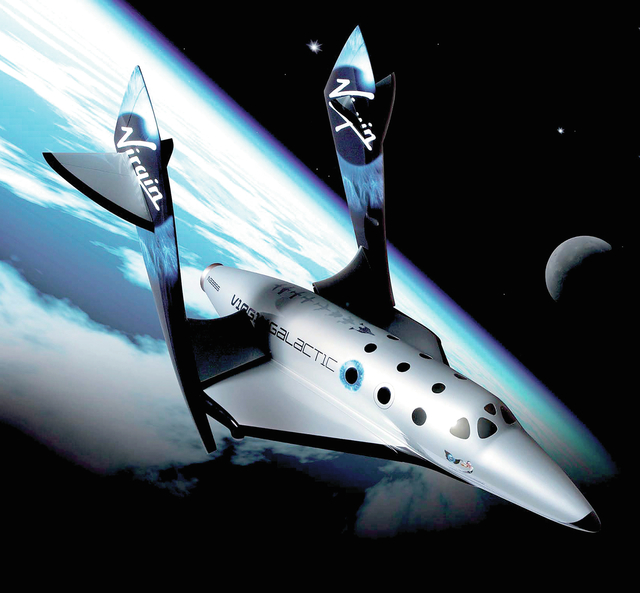KAILUA-KONA — A proposed spaceport at Kona International Airport could open up new economic opportunities for space tourism on the island.
KAILUA-KONA — A proposed spaceport at Kona International Airport could open up new economic opportunities for space tourism on the island.
A draft environmental assessment for the proposal is still in the works and would need to pass approval by the Federal Aviation Administration before it opens up to commercial ventures.
Jim Crisafulli, aerospace program manager for the state’s Office of Aerospace Development, said Kona International Airport was selected as the best of 26 options for a potential spaceport.
That decision was made based on the airport’s proximity to the ocean and distance from residential areas. The existing runway and infrastructure that could support spaceplanes also played into decision making, Crisafulli said.
The spaceport would only support spaceplanes that launch and land horizontally, similar to conventional aircraft. The spaceport wouldn’t support vertical takeoff.
Among the proposed operations is one that would launch tourists into suborbit, sending tourists up to the edge of space and putting Kona on the map as a potential hub for space tourism.
That’s an exciting prospect for Kirstin Kahaloa, executive director of the Kona-Kohala Chamber of Commerce.
Space tourism, she said, is a chance to “enhance our uniqueness” that would also diversify Kona’s opportunities for tourism.
“The more opportunities for a sustainable and diverse industry in our community and providing another industry, that’s going to really impact our economy,” she said.
Kahaloa also touted the Big Island’s connection to astronomy, saying that and aerospace go hand in hand.
“We want to see Hawaii Island and the state of Hawaii as a place for astronomy, and here’s another thread of that,” she said. “We add our aerospace.”
Crisafulli said several space launch companies have already expressed interest in operating at the spaceport, though he didn’t identify any specifically.
In addition to space tourism, Crisafulli said spaceplanes could also be used to launch Earth-orbiting satellites, interplanetary probes or experimental payloads.
Kahaloa said that because the process is still in its early stages, they haven’t been coordinating with potential space tourism businesses. However, she said, the chamber is keeping an eye on “aerospace as an emerging industry.”
Kahaloa also said she’s convinced having the spaceport will encourage operators to set up shop here.
“If we have a spaceport, people will come,” she said.
She said, however, that is conditional on making sure the approval process is done completely and gathering community support.
“There’s a lot of factors for new industries coming into our community, and I think what’s important is that we see astronomy trying to grow in our community, and it hasn’t been able to yet,” she said, citing uncertainty about the Thirty Meter Telescope. “We need to, as a community, support another emerging industry and make sure that it can come to fruition because there’s policies, procedures, things that need to be done in order to get the spaceport here.”
A draft environmental assessment is already underway, said Crisafulli. That assessment takes into consideration the potential impacts a spaceport would have on air quality, coastal resources, ambient noise, public safety and effects on the natural environment.
That draft will be reviewed during a public meeting, which is anticipated to take place later this year or early next year.
After a 30-day review period, Crisafulli said, the draft assessment will be converted to a final environmental assessment, which the FAA will review.
From there, the FAA can either issue a finding of no significant impact or instruct the state to conduct a federal environmental impact statement.
Crisafulli added that when the state submits the final assessment, it also will submit its application for a spaceport license.
From there, he said, there’s a 180-day review period for the assessment and application before the FAA can award a spaceport operator license, assuming the agency finds the spaceport won’t have a significant impact on its surroundings.
Because of their similarity to conventional aircraft, Crisafulli said, there won’t need to be many changes made at the airport.
“Many of these vehicles are similar in size to small business jets, and much of the existing infrastructure at (the airport) can be utilized to support spaceplane launches — including runways and hangars,” Crisafulli said.
Improvements to the airport would include construction of a new pad for fueling spaceplanes. Additionally, operators may want to build a specific hangar or office space for their own operations.
“These facilities can be constructed for dual-use and incorporated directly into airport-related service as required,” he said,
Crisafulli added that even if the state receives a license to run the spaceport, individual operators would still need to get their own licenses in order to operate out of it.
The effect on the economy wouldn’t be limited to spaceplane operators, Kahaloa said.
“It’s not just aerospace as an industry but it’s all the businesses that get supported through aerospace,” she said.
Space tourism also has the potential to promote higher-end retail businesses and resorts, as well as a variety of other business opportunities to accommodate high-end clientele.
She said it also could lead to an increase in private planes flying to Kona, which would bring with it new opportunities for business, jobs and economic growth.

